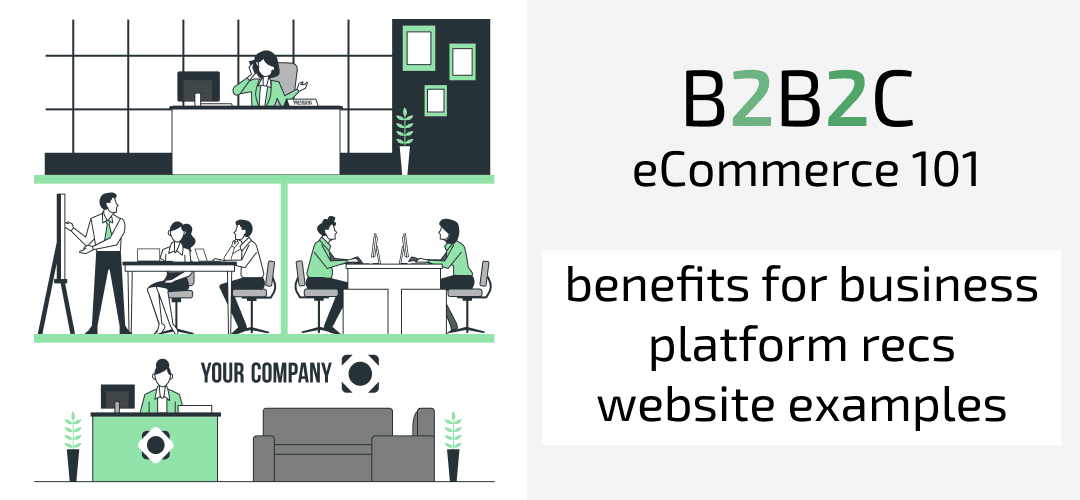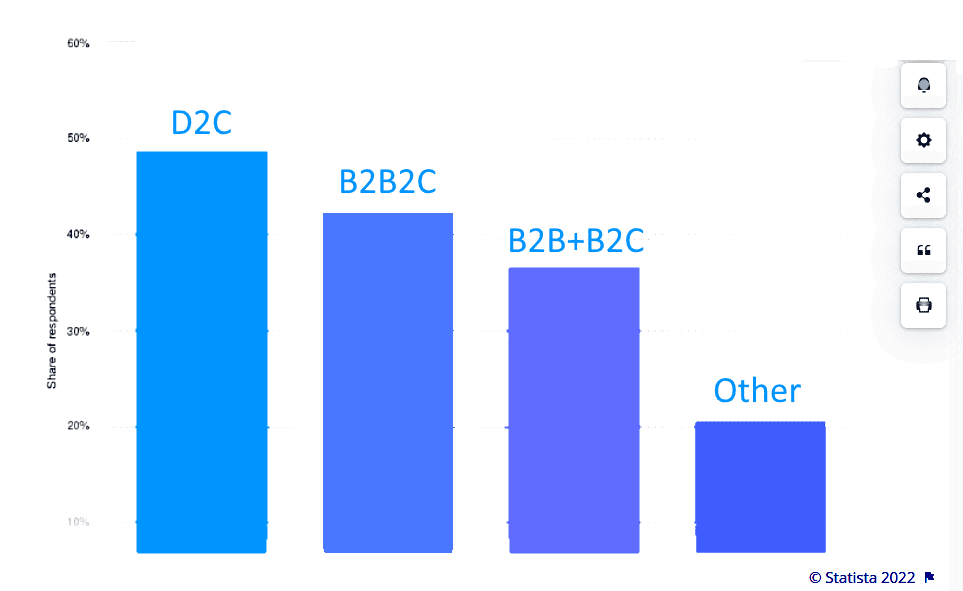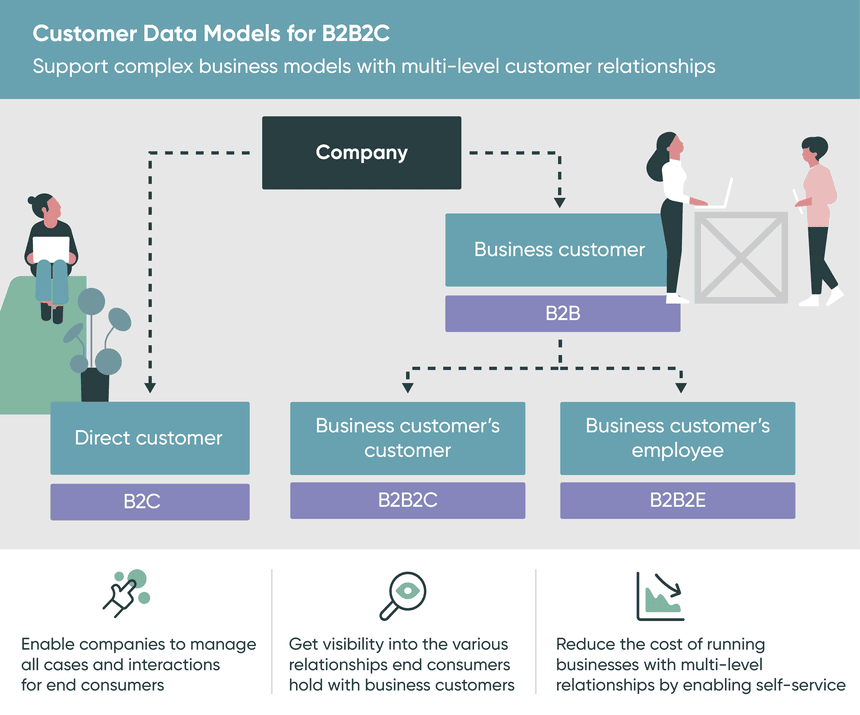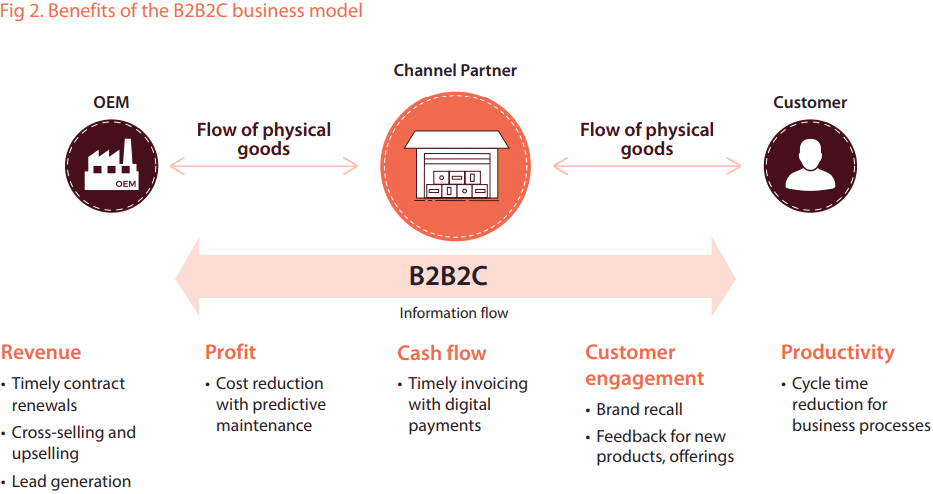
If you’re looking for a suitable eCommerce business model, there’s quite a long list, including B2C, B2B, D2C, B2G, B2B2C, B2B2B, C2B2B, B2C2B, etc. Each of them describes the go-to-market strategy, pricing policy, stakeholder participation, distribution methods, and products offered. However, the distinctions between these sales channels have become more hazy as a result of the rapid development of eCommerce and remote employment.
As a result, more companies are switching to B2B2C eCommerce as it combines business-to-business (B2B) and business-to-consumer (B2C) into a single online trading model for a complete product or service transaction.
According to one of recent surveys, almost half of companies (48.7%) said they sold products to final consumers online without intermediaries (D2C). 42.3% of respondents preferred selling products to final consumers using marketplaces (B2B2C). And only 36.5% of the interviewed resorted to traditional B2B, where manufacturers sell their products to distributors or retailers, without a direct contact with the end-user.

In this blog post, we’ll dwell on the B2B2C definition, the benefits of this business model, tips on choosing an eCommerce platform that can fulfill such objectives and the best examples of B2B2C websites to look for valuable insights.
What is B2BC eCommerce: B2B vs B2C vs B2B2C
As mentioned above, B2B2C stands for business-to-business-to-consumer. What’s B2B and B2C in this model? Do they work in a chain or are combined in a more efficient way?
In B2B eCommerce, one company markets its goods and services to another. B2C eCommerce communicates with customers directly. B2B2C is a new strategy for establishing connections between B2B companies, where a business entity partners with another to sell its product or service to the end customer.
Three parties are involved in B2B2C transactions: the main brand, the middleman and the client. Customers know that they are purchasing from the brand. The intermediary's goal is to offer direct service at client touchpoints, resulting in a win-win situation for both companies.

The B2B2C customer base consists of wholesalers, manufacturers, distributors, retailers, etc. It's crucial to keep in mind that the B2B2C model differs from conventional reselling since its monetization is built over commissions taken from any first B goods sold by second B. On the contrary, traditional "B2B plus B2C" reselling relies on price-based revenue (buy wholesale cheaper, sell in smaller bunches, or retail at a higher price).
Within this approach, first B determines the ultimate cost to the consumer, while second B earns a commission on each sale. However, there might be price cap agreements and marketing campaigns to increase demand, keeping the price appealing to customers.
B2B2C eCommerce removes the middlemen between B2B and B2C business models on the online market, allowing companies to engage with customers directly. As a result, the consumer base expands, offering enterprises new chances for revenue generation.
B2B2C benefits you can’t afford to miss
In the modern world, where most sales procedures are outdated, a lot of time and effort is required to prepare custom quotes and manufacture custom products, which lengthens the sales cycle. The simple thing that helps B2B2C eCommerce solve these problems and makes it a win-win model for all the parties involved is its flexibility and adaptability to current changes.
B2B2C relationships allow the first B to reach more potential clients. At the same time, it creates a revenue stream for the second B and the latter offers its clients new goods and/or services. The C benefits from a greater diversification of products and/or services.
The B2B2C eCommerce model has great prospects for business growth and cost reductions for small manufacturers and startups. This is a strategy to increase sales – not just in local markets, but also by establishing a reputation in other regions where the second B is active.
Instead of putting all eggs into one basket, B2B2C eCommerce helps companies address two sides simultaneously and benefit from other significant advantages.
Improved brand credibility
Businesses often engage in B2B2C partnerships in order to increase their brand credibility by teaming up with organizations that their target market already knows and trusts. This collaboration as a whole will be boosted by the potential for both enterprises to offer credibility in various markets.
Fully manageable supply chain
Manufacturing companies no longer require a middleman to deliver their products to customers – as a result, they are able to take over the supply chain.
Customers want to receive products as soon as possible. While traditional B2B and B2C models are unable to promptly satisfy client requests, the B2B2C eCommerce model is more successful in this sense. It allows producers to provide things more swiftly.
Less overhead expenses
The number of clients that a company can reach is limited when it only offers goods and services to other businesses. However, by adopting the B2B2C eCommerce model, a business entity can sell to a wider customer base through an intermediary.
By eliminating the need for B2B2C marketing and advertising, this not only boosts sales but also reduces costs. Through the elimination of logistical expenses like product delivery and storage, businesses might lower their overhead. In addition, much money is required for entering a new market. By minimizing the need for companies to create the capacity to supply goods or services on their own, B2B2C partnerships can help lower these costs.

Access to larger customer bases
Through the B2B2C eCommerce model, businesses can offer goods and services directly to their customers or use such an intermediary as a marketplace, online merchant or even social network.
Pre-existing connections can substantially facilitate the B2B2C eCommerce structure. These connections could result in a large-scale acquisition of customers. This advantage alone can make B2B2C a valuable eCommerce model, especially given the high cost of customer acquisition.
Seamless experience for customers
Businesses can provide customers with a smooth experience by acting as their one-stop shop for all product requirements. Clients can purchase what they require directly from the company's website or through a middleman (online retailer or marketplace). Consequently, the B2B2C eCommerce strategy not only reaches a broader audience, but also provides better customer service.
Recommendations for choosing your B2B2C eCommerce platform
B2B2C companies can come in a variety of sizes and shapes, including small businesses seeking a digital agency to improve their products and services, and expand consumer base; a tech start-up offering its services to other companies; a new marketplace, etc.
Although these businesses are quite different and have different needs, one of the main requirements is robust software to power multi-channel operations. All-in-one B2B2C eCommerce platforms must provide sufficient features, including:
- Both B2B and B2C oriented functions
- Highly-customized architecture
- Easy to integrate with third-party apps and services.
As this type of eCommerce requires flexibility and customization, open-source software seems to better suit the task than SaaS (software-as-a-service) solutions. For B2B2C eCommerce, we can recommend several platforms (note that the list isn’t exhaustive, though, and can include dozens of candidates).
These top-picked platforms have a lot of powerful features, including built-in marketing tools, support for multiple currencies and tax rates, and extensive customization capabilities.
- nopCommerce is an open-source hybrid eCommerce platform that comes with plenty of B2B features out-of-the-box. It supports B2C, B2B, B2B2C, B2X, wholesale, multi-store, multi-vendor and marketplace selling options. Other powerful functions include (absolutely for free): integration with CRM, PIM, ERP, WMS systems; customer roles and multi-tier pricing; multi-language and multi-currency support.
- Spryker might not have as many features but offers a lot of customization for the store’s design and layout. This is a suitable solution for B2B, D2C and enterprise marketplaces. The platform also supports unlimited products, CPQ, personalized catalogs and pricing, etc.
- Adobe Commerce is one of the most widely used open-source platforms. Despite having a robust structure, the software can be also extended with hundreds of additional modules. Its B2B features include: shared catalogs; quick order; negotiated prices; automatic order approval, etc. However, the ownership cost is quite high and starts from $22,000 per year.
Best B2B2C eCommerce website examples
With the rising popularity of this eCommerce model, it’s only natural that many companies use it to strengthen their digital presence and serve more customers. Here are a few B2B2C examples that utilize the best features you might want to integrate into your own online store:
- Amazon is a great B2B2C retail example allowing both customers and other businesses to shop on its online marketplace. The company serves as a hosting to various manufacturers and brands, which benefit from a wider audience than most could ever create on their own. Customers get expedited shipping methods, 24/7 tech support, and more.
- UberEats combines B2B and B2C models. The company (Business A) sells its delivery service to restaurants, groceries and shops (Business B) which then sell the delivery services to buyers (Customers)
- eBay is yet another marketplace with B2B2C dynamics, serving both casual and power users. The platform offers different seller tools for individual sellers, SMBs and larger merchants.
Consumers use such B2B2C models to order goods or services from another company, and obtain products more quickly. Businesses that produce more expensive goods can reach a wider audience if provided with flexible financing alternatives.
B2C adopting B2B with nopCommerce
Speaking about more local success stories, Ofix, a sizable office and school supply business in Mexico, was first established as a B2C business but later decided to enter the B2B sector as well. As a result, this company represents the very B2B2C meaning.

Ofix required a website that could offer both B2C retail sales to end users and B2B wholesale sales of office supplies to businesses. It was chosen to split the flows of B2C and B2B clients since the functionality and catalogs needed to differ dramatically. Retail sales centered on Ofix, which the clients were already familiar with. The Office Club website was made with the business segment and wholesale sales in mind.
10,000 goods are now available on the B2C Ofix website following the switch to nopCommerce. The Ofix website has evolved into the ultimate sales channel with approximately 300,000 visitors per month. The needs of all consumers are satisfied by the new B2B eCommerce market with customized functionality.
Final word
If you're looking for an effective strategy to sell online, B2B2C eCommerce is totally worth your attention. The model can assist you in scaling your client acquisition efforts by using several partners and sales channels for various purposes.
Yet, managing profitable B2B2C operations is difficult, particularly when it comes to negotiating win-win partnership conditions, assuring data transfers and a consistent consumer experience across all distribution channels, managing a supply chain, and determining customer ownership.
However, with professional tools, a customizable data display and specified marketing options, nopCommerce is a great B2B2C eCommerce platform with lower costs and high efficiencies.